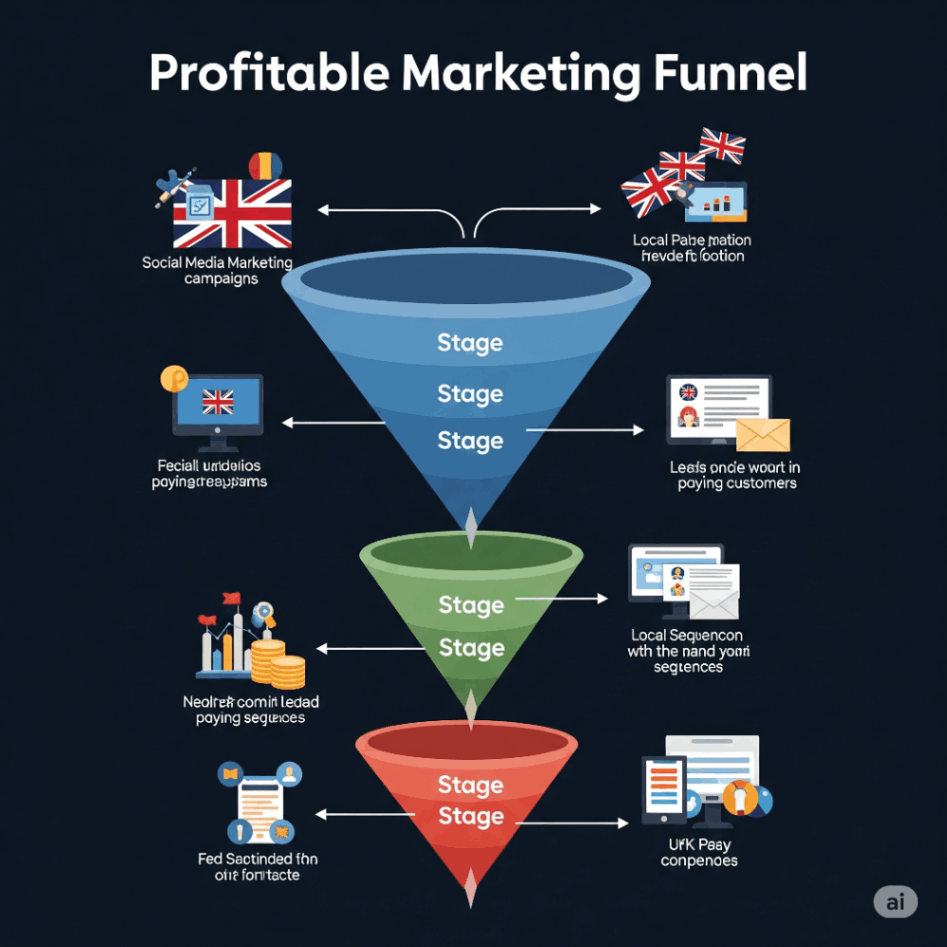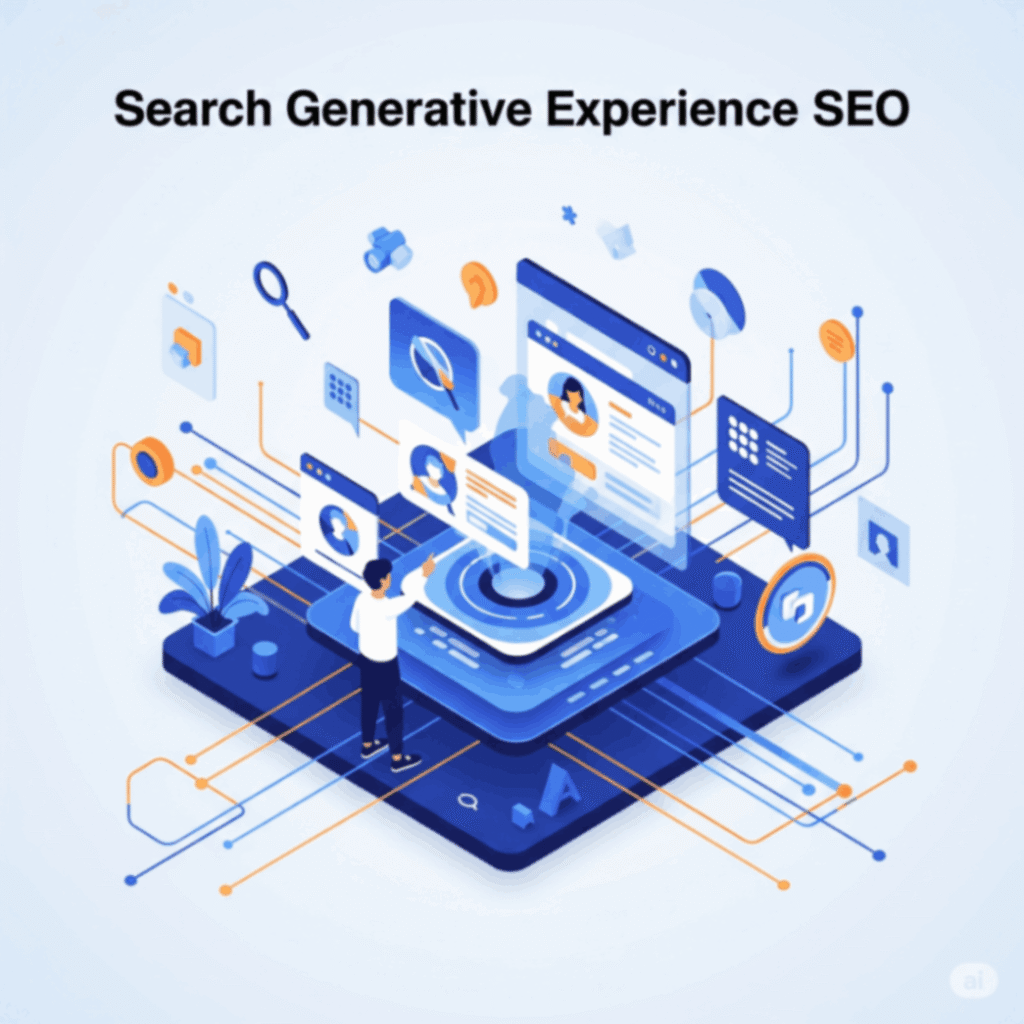Introduction
Understanding how to build a profitable digital marketing funnel is crucial for any business aiming to increase online conversions and sales. A well-structured funnel guides potential customers through each stage of the buying journey, from awareness to purchase, while maximising profitability. In 2025, businesses of all sizes can benefit from a strategic approach to digital funnels, leveraging content marketing, email automation, and paid ads to optimise every stage of the customer journey. This guide provides practical, actionable steps for building an effective and profitable digital marketing funnel.
What is a Digital Marketing Funnel?
A digital marketing funnel represents the journey a potential customer takes from first discovering your business to becoming a paying customer. It consists of several stages, each with specific objectives and strategies.
Typical Funnel Stages:
-
Awareness: Capturing the attention of potential customers.
-
Interest: Engaging visitors with valuable information.
-
Consideration: Nurturing leads through targeted content and offers.
-
Conversion: Turning leads into paying customers.
-
Retention: Encouraging repeat purchases and brand loyalty.
Why Digital Marketing Funnels Matter
A profitable digital marketing funnel delivers multiple benefits:
-
Increased Conversions: Converts more visitors into customers.
-
Higher Revenue: Maximises lifetime value through upsells and repeat sales.
-
Improved Customer Experience: Offers personalised, relevant touchpoints.
-
Reduced Acquisition Costs: Makes marketing spend more efficient.
-
Scalability: Builds a repeatable system for consistent growth.
Step 1: Define Your Funnel Goals and Target Audience
Before building your funnel, establish clear objectives and understand your target market.
Funnel Goal Examples:
-
Generate 500 qualified leads per month
-
Achieve a 5% conversion rate from lead to customer
-
Increase average order value by 15% through upsells
-
Improve customer lifetime value by 20%
Identify Your Target Audience:
-
Demographics: Age, location, gender
-
Interests: Hobbies, preferences
-
Pain Points: Challenges your product/service solves
-
Buying Behaviour: Online activity, purchasing habits
Step 2: Create High-Quality Awareness Content
At the top of the funnel (TOFU), your goal is to attract and engage a broad audience.
Effective TOFU Strategies:
-
SEO-Optimised Blog Posts: Drive organic traffic (BBC Business).
-
Social Media Content: Short videos, reels, infographics.
-
Lead Magnets: Free resources like e-books, templates, or guides.
-
Paid Ads: Google Ads, Facebook Ads targeting cold audiences.
| Awareness Strategy | Purpose | Example Content |
|---|---|---|
| Blog Articles | Drive search traffic | “Top 10 Strategies to Boost E-commerce Sales” |
| YouTube Videos | Build brand awareness | Product demos, industry tips |
| Social Media Posts | Engage audiences on platforms | LinkedIn posts, Instagram reels |
| Webinars | Educate and nurture leads | Free online training sessions |
Step 3: Build Lead Capture Mechanisms
Converting awareness into interest involves capturing visitor information to nurture them further.
Key Lead Capture Tools:
-
Landing Pages: Dedicated pages with clear calls-to-action (CTAs).
-
Opt-In Forms: Embedded on blog posts or pop-ups.
-
Quizzes/Surveys: Interactive methods to segment leads.
-
Email Signup Incentives: Discounts, downloadable resources.
Best Practices:
-
Use simple, distraction-free landing pages.
-
Offer valuable lead magnets relevant to your product.
-
Optimise opt-in forms for mobile devices.
Step 4: Nurture Leads with Email Marketing
Middle of the funnel (MOFU) strategies focus on building relationships with your leads.
Email Marketing Tactics:
-
Welcome Series: Introduce your brand and key products.
-
Educational Content: Provide tips, how-to guides, and product usage information.
-
Personalised Product Recommendations: Based on user behaviour.
-
Exclusive Offers: Encourage small conversions (e.g., first-time purchase discounts).
| Email Campaign Type | Goal | Example Subject Line |
|---|---|---|
| Welcome Email | Establish brand connection | “Welcome! Here’s 10% off your first order.” |
| Educational Series | Build trust and interest | “How to solve [pain point] quickly” |
| Product Recommendation Email | Drive sales with relevance | “Recommended just for you” |
| Limited-Time Offer | Create urgency for conversion | “48 Hours Only: Save 25% on Your Favourite” |
Step 5: Convert Leads into Paying Customers
Bottom of the funnel (BOFU) strategies help close the sale.
High-Converting BOFU Tactics:
-
Retargeting Ads: Serve targeted ads to website visitors or email subscribers.
-
Product Demos/Consultations: Offer free trials, product demos, or consultations.
-
Customer Testimonials/Case Studies: Build trust with social proof.
-
Discounts and Incentives: Limited-time offers to drive urgency.
| BOFU Strategy | Conversion Goal |
|---|---|
| Retargeting Campaigns | Re-engage site visitors |
| Case Studies | Build credibility and trust |
| Product Demos | Remove objections and increase conversions |
| Limited-Time Discounts | Create urgency to buy |
Step 6: Increase Profitability Through Upsells and Cross-Sells
Maximise profitability after conversion through:
-
Upsells: Offer premium versions or add-ons post-purchase.
-
Cross-Sells: Recommend complementary products.
-
Bundle Offers: Group products/services for higher order value.
-
Loyalty Programs: Reward repeat customers with points or discounts.
Examples of Profitable Upsell Techniques:
| Upsell Technique | Example |
|---|---|
| Product Upgrade | “Upgrade to premium for only £10 more” |
| Complementary Add-on | “Add a protection plan to your device.” |
| Bundle Offer | “Buy 2, get 1 free” |
| Loyalty Reward | “Earn 200 points with this purchase.” |
Step 7: Retain Customers with Post-Sale Engagement
The funnel does not end after purchase. Focus on retention and repeat sales.
Post-Sale Strategies:
-
Follow-up Emails: Thank-you messages, product care tips.
-
Replenishment Reminders: Remind customers when it’s time to restock.
-
Feedback Requests: Collect reviews and testimonials.
-
VIP Offers: Early access to new products or exclusive deals.
Step 8: Optimise and Automate Your Funnel
Tools to Automate Funnel Management:
-
Email Automation: Mailchimp, ConvertKit, Klaviyo.
-
CRM Automation: HubSpot, Salesforce, Zoho CRM.
-
Sales Funnels: ClickFunnels, Leadpages.
-
Analytics Tools: Google Analytics, Hotjar for funnel tracking.
Optimisation Tips:
-
Split test landing pages and email subject lines.
-
Use analytics to identify bottlenecks.
-
Regularly update content to remain relevant.
-
Review customer feedback for continuous improvement.
Conclusion
Mastering how to build a profitable digital marketing funnel enables businesses to attract, convert, and retain customers more effectively. By strategically guiding prospects through each stage — from awareness to retention — you create a sustainable model for revenue growth. Use targeted content, efficient automation tools, and consistent optimisation to ensure long-term profitability from your digital marketing efforts.
FAQ: How to Build a Profitable Digital Marketing Funnel
1. What is the most important part of a digital marketing funnel?
Every stage is essential, but converting leads to customers (BOFU) has the most direct impact on revenue.
2. How long does it take to build an effective funnel?
Setting up a basic funnel can take a few weeks. Optimising it for profitability typically takes 2-3 months of testing and refinement.
3. Can small businesses afford to build a digital marketing funnel?
Yes, many affordable tools (like Mailchimp, ConvertKit) are available for small businesses to build effective funnels on a budget.
4. Should I hire an agency or build my funnel in-house?
It depends on your resources. Agencies offer speed and expertise, while in-house teams offer better control and long-term savings.
5. How do I measure the success of my funnel?
Track key metrics like conversion rates, customer acquisition cost (CAC), average order value (AOV), and customer lifetime value (CLV).
For more marketing strategies, growth tips, and practical business resources, visit DerekTime and explore our expert guides tailored for UK businesses.


